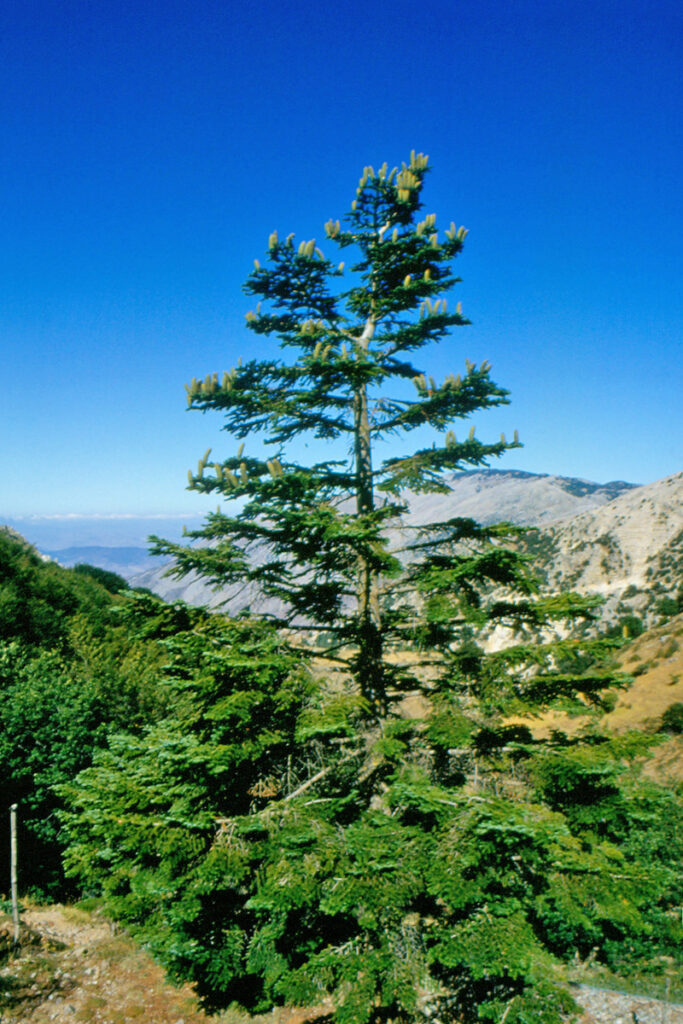
Sicilian Fir Facts
- This majestic example of botanical beauty is most typically referred to by the informative common name of the Sicilian Fir. For the moment, the flora has no other broadly accepted general title. Though unusual for a tree, that’s certainly not unknown.
- The term by which it’s likely better known among scientists, however, is quite different. Thankfully, though, it’s a comparatively easy name for the layperson to pronounce. That’s because this marvel of evolution holds the formal title of Abies nebrodensis.
- It owes that moniker to the combined efforts of two individuals. The Italian botanist, Michele Lojacono, began the work, and her countryman, Giovanni Ettore Mattei, completed it. Between them, they recorded its first recognition as a separate species.
- Sadly, the remarkable Sicilian Fir now finds itself in a dire predicament. Its population base, always limited, has now plummeted precipitously. Only 25 mature examples remain. Due to this fact, the IUCN now lists the beautiful tree as Critically Endangered.
- The primary cause of its near disappearance stems directly from the actions of humans. That’s true since this decline occurred due to deforestation of its habitat. Because of its tiny population, it’s also now especially vulnerable to the danger of climate change.
Related Articles
Sicilian Fir Physical Description
When viewed by those lucky enough to encounter it, the fabulous Sicilian Fir typically captures their attention. It does so, however, principally due to a combination of its own appearance, and how it stands out amid its surroundings. It’s another of Nature’s wonders.
In terms of sheer size, though, it only ranks as approximately average-sized among the members of its Class. The mature specimens still in existence range in height from 49.2 – 82 ft (15- 25 m). It’s not recorded if earlier examples ever exceeded this measurements.
Given its height, the width of the trunk remains comparatively impressive in relation. This part of the lovely Gymnosperm attains an average diameter of 3.3 ft (1 m) at the breast height. Taken at 4.5 ft (1.37 m) above ground, that’s a standard reference for botanists.
This aspect of the tree holds its own distinctiveness. It displays a light gray color across its length. Though smooth when young, this slowly becomes scaly with age. At full maturity, this also becomes furrowed, most especially at or near the base of the fascinating tree.
The leaves of the Sicilian Fir also merit note. Like most of its kin, its foliage develop as needle-like structures. Flattened in shape, these average 0.6 – 1.0 in (1.5 – 2.5 cm) in length. The surface shows a glossy dark green, with two greenish-white bands on the underside.
The seed cones it produces reach typical lengths equaling roughly 4 – 6.4 in (10 – 16 cm) in length. Their width averages about 1.6 in (4 cm). Each of these generally presents around 150 scales. Winged in design, the seeds range in size from 0.32 – 0.4 in (0.8 – 1.0 cm).
- Kingdom: Plantae
- Phylum: Tracheophytes
- Class: Pinopsida
- Order: Pinales
- Family: Pinaceae
- Genus: Abies
- Species: A. nebrodensis
Sicilian Fir Distribution, Habitat, and Ecology
The Sicilian Fir evolved as native to a region of the globe renowned for its many natural marvels. That includes both geological, and, as in this case, botanical. That’s due to the fact that this creation of Nature and evolution developed as endemic to the continent of Europe.
Yet within that greater area, its zone of habitation is actually quite small. The precise location of its presence, however, probably won’t surprise anyone. That’s because, as its name indicates, it’s native to the region of the country of Italy bearing the name of Sicily.
The species also shows decided preferences in regards to its choice of habitat. It’s a montane flora, evolved for the higher elevations. Presently, it only appears on Mt. Scalone, in the Madonie Mountains. All examples live at altitudes between 4,593 – 5,249 ft (1,400-1,600 m).
Even there, this remarkable flora only lives in some areas. These consist of dry, steep slopes. In these locations, it either grows alone in small stands, or scattered in with other trees. The latter specimens mix in with shrubs and other trees, most notably black pine.
The Sicilian Fir is a coniferous evergreen. As such, each tree produces both male and female seed cones. Following the complete ripening of the seeds inside the female cone, the container disintegrates. The exposed seeds then naturally fall to the surrounding terrain.
Replanting programs exist, yet these show only limited success. Heavy grazing by livestock of local faremrs, combined with the actions of indigenous animals, severely limits new growth. These efforts do continue, though, in an attempt to preserve the amazing species.
Species Sharing Its Range
Check out our other articles on 6 Mysterious Natural Phenomena, Striped Skunk, Mount Kinabalu, Southern Darwin’s Frog, Genji-botaru, Indigo Milk Cap, Rough-nosed Horned-Lizard
